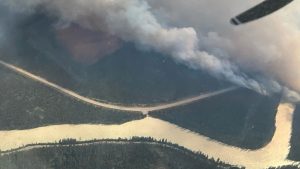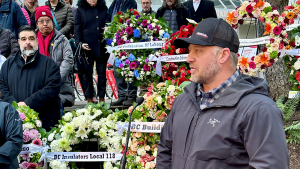Lytton Mayor Denise O’Connor is looking at 2025 as the year the village starts the rebuild of the municipal buildings lost in the 2021 fire that destroyed the downtown core.
“We are told any day now,” she said in early November.
The fire destroyed buildings in a seven-block area and amongst the razed 90 buildings were the village office, fire hall, museum, visitor’s centre and public works building. The town’s open-air pool facilities were also impacted.
“We were told the cement was compromised and it had to be removed,” she said.
In June 2022, the village was promised $64 million for municipal buildings from Infrastructure ���ϳԹ���.
“It’s kind of backwards,” said O’Connor, adding while the town has been promised the dollars, it still has to apply for grant money for projects under ���ϳԹ���’s Green and Inclusive Community Buildings (GICB) program.
Each project looking for funding under the GICB program must be a community or public structure, built to a net-zero and FireSmart standard as well as meet accessibility requirements. It must have conducted environmental and species-at-risk assessments and include First Nations in the planning, building and post-construction phase. Each project must go to a request for proposals or receive quotes from three contractors.
The three-year delay has resulted from both the village and residents waiting for debris removal and an archeological site assessment carried out onsites while the village staff had to go through the GICB’s assessment and planning requirements before filing an application.
A community hub is the first building to have met the criteria and an application has been set forward, after an architectural and final design was completed in fall 2024. O’Connor is looking to begin procurement and construction in the spring of 2025.
“We are looking to include things such as space for a farmer’s market, public washrooms, a library and museum, and multi-purpose areas,” she said.
The village has purchased a hotel property where the owner decided not to rebuild for the new community hub, she said.
The site could also house a new village office, but that is not considered eligible under the grant funding and that cost would not be covered by GICB program, O’Connor added. The village’s capital plan is also looking at rebuilding the office and council facilities on its Main Street and incorporating a visitor’s office.
O’Connor said she hoping a new outdoor pool will start in 2025 under the GICB program. The fire destroyed the pool ancillary buildings, but the pool, which was filled, was left during winter and the concrete was compromised.
The fire hall and rescue building are also being built under the GICB funding program but is still in a consulting stage. The building will move to a new site when plans are finalized. The village’s capital plan does not expect construction to begin until late 2025 or 2026. A temporary fire hall has been set up.
A request for proposals for the village’s public works building, which is not covered under the GICB, was issued in March for a design-build concept. The contract was awarded to Blue Collar Modular, however, construction has yet to start, O’Connor said.
There exists road and sidewalk damage caused by heavy equipment that was involved in debris removal but O’Connor said that finalizing roads and sidewalk work will be left until the new infrastructure is in place as more heavy equipment may be brought to the area.
The village was fortunate that it did not lose is water treatment centre and its sewage treatment centre. While downtown residential areas were impacted by the 2021 fire, the village still has 40 homes near the highway that needed servicing.
The fire debris clean-up and archeological site assessment impacted some of the service pipes for water and sewage.
A $5 million grant from the Union of BC Municipalities was received for water system upgrades, including some smaller projects where leaks were detected. A capital re-investment plan is underway.
A grant of $5.5 million from the ���ϳԹ���/BC Investing in ���ϳԹ��� Infrastructure program for sewer system upgrades has been obtained as well as $4.4 million from the B.C. government for sewer upgrades and associated archeology costs.
The work in building the residential sector has been slow because of assessments that had to be carried out, but new homes are built and new building permits have been issued.
Contractors are still facing challenges, O’Connor said, as there are no hotels or restaurants. A local provincial campground was only open during the summer.
A nearby First Nation, which is also going through rebuilding, has some camp accommodations available for its contractors and other contractors. But, contractors are travelling from areas such as Kamloops and Chilliwack, she said.











Recent Comments
comments for this post are closed